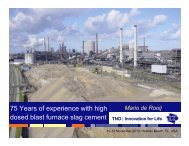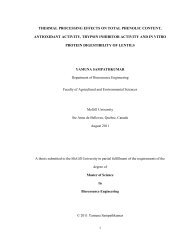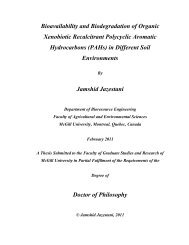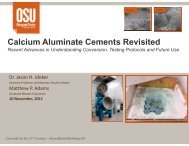Postharvest treatments to reduce chilling injury symptoms in stored ...
Postharvest treatments to reduce chilling injury symptoms in stored ...
Postharvest treatments to reduce chilling injury symptoms in stored ...
Create successful ePaper yourself
Turn your PDF publications into a flip-book with our unique Google optimized e-Paper software.
temperatures with one or more exposure <strong>to</strong> non-<strong>chill<strong>in</strong>g</strong> (higher) temperatures.<br />
Rewarm<strong>in</strong>g allows metabolism of the <strong>to</strong>xic products which accumulates <strong>in</strong> the tissues at<br />
low temperature (Pentzer and He<strong>in</strong>z, 1954) and also res<strong>to</strong>res certa<strong>in</strong> depleted essential<br />
metabolites. Rewarm<strong>in</strong>g also allows the revival of oxidative phosphorylation <strong>in</strong> tissues as<br />
it gets suppressed at low temperatures.<br />
Temperature condition<strong>in</strong>g <strong>in</strong>volves s<strong>to</strong>rage of products above the <strong>chill<strong>in</strong>g</strong><br />
threshold temperature before they are s<strong>to</strong>red at a low temperature (Wade, 1979). This<br />
may be a s<strong>in</strong>gle step operation or may be achieved <strong>in</strong> multi-steps by gradually decreas<strong>in</strong>g<br />
the temperature. However, a s<strong>in</strong>gle step condition<strong>in</strong>g is less effective than a multi-step<br />
condition<strong>in</strong>g.<br />
Jacobi et al., (1995, 1996) reported that condition<strong>in</strong>g of mango fruit cv.<br />
Kens<strong>in</strong>g<strong>to</strong>n at 40°C <strong>in</strong>creased heat <strong>to</strong>lerance and <strong>reduce</strong>d the effect of heat <strong><strong>in</strong>jury</strong>.<br />
Accord<strong>in</strong>g <strong>to</strong> these reports, those fruits which received HW condition<strong>in</strong>g treatment at 40<br />
ºC for 8-12 h had m<strong>in</strong>imum heat <strong><strong>in</strong>jury</strong> and showed <strong>in</strong>ternal and external cavities and<br />
starchy layer beneath the sk<strong>in</strong>. Heat-treatment effectively <strong>in</strong>creases fruit heat <strong>to</strong>lerance<br />
and <strong>reduce</strong>s CI <strong>in</strong> s<strong>to</strong>red avocado (Woolf et al., 1995). There are different techniques<br />
which are used <strong>to</strong> m<strong>in</strong>imize the <strong>in</strong>cidence of CI.<br />
2.5.1 Use of heat-treatment<br />
Different heat-<strong>treatments</strong> have been used <strong>to</strong> alleviate the <strong>in</strong>cidence of CI<br />
symp<strong>to</strong>ms <strong>in</strong> mango fruits. VHT-treated mango fruits showed <strong>in</strong>creased level of<br />
putresc<strong>in</strong>e and its accumulation helped the reduction of CI (Esguera and Lizada, 1990).<br />
As stated by González et al. (2000) peppers treated with HW at 53 °C for 4 m<strong>in</strong>, had a<br />
<strong>reduce</strong>d <strong>in</strong>cidence of CI after 14 and 28 days s<strong>to</strong>rage at 8 °C. It has been hypothesized<br />
that HW-treated fruits show <strong>in</strong>creased level of polyam<strong>in</strong>e which <strong>reduce</strong>s CI symp<strong>to</strong>ms <strong>in</strong><br />
fruits (González, 1997).<br />
Ethylene-treated fruits, irrespective of the method of application, cause severe<br />
mesocarp discoloration <strong>in</strong> avocado fruits. Loss of green color has been observed <strong>in</strong> plant<br />
tissues while they are treated with Ethylene. The treatment also decreases fruit firmness,<br />
and CI dur<strong>in</strong>g prolonged s<strong>to</strong>rage (Watada, 1986). The mechanism by which ethylene<br />
19









